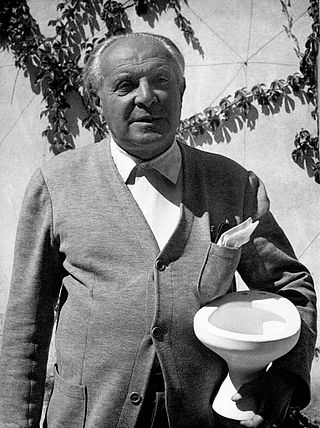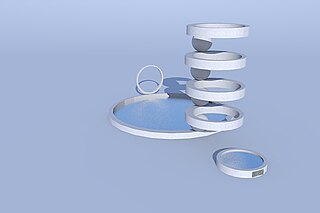Related Research Articles

Monza is a city and comune (municipality) on the River Lambro, a tributary of the River Po, in the Lombardy region of Italy, about 15 kilometres north-northeast of Milan. It is the capital of the province of Monza and Brianza. Monza is best known for its Grand Prix motor racing circuit, the Autodromo Nazionale di Monza, which hosts the Formula One Italian Grand Prix.

Fortunato Depero was an Italian futurist painter, writer, sculptor, and graphic designer.

Giovanni "Gio" Ponti was an Italian architect, industrial designer, furniture designer, artist, teacher, writer and publisher.

The Royal Villa is a historical building in Monza, northern Italy. It lies on the banks of the Lambro river, surrounded by the large Monza Park, one of the largest enclosed parks in Europe.

Enrico Crispolti was an Italian art critic, curator and art historian. From 1984 to 2005, he was professor of history of contemporary art at the Università degli Studi di Siena, and director of the school of specialisation in art history. He previously taught at the Accademia di Belle Arti in Rome (1966–1973) and at the Università degli Studi di Salerno (1973–1984). He was author of the catalogues raisonnés of the works of Enrico Baj, Lucio Fontana and Renato Guttuso. He died in Rome on 8 December 2018.
The Milan Triennial is an art and design exhibition that takes place every three years at the Triennale di Milano Museum in Milan, Italy.

The Milan Triennial VI was the Triennial in Milan sanctioned by the Bureau of International Expositions (BIE). Its theme was Continuity – Modernity. It was held at the Palazzo dell'Arte with some exhibits on the Parco Sempione and ran from 31 May 1936 - 1 November 1936.

The Milan Triennial VII was the triennial in Milan sanctioned by the Bureau of International Expositions (BIE) on the 9 November 1938. Its theme was Order - Tradition. It was held at the Palazzo dell'Arte and ran from 6 April 1940 to 9 June 1940, when Italy entered the Second World War.
The Milan Triennial IX was the Triennial in Milan sanctioned by the Bureau of International Expositions (BIE) on the 7 June 1950. Its theme was Goods - Standard. It was held at the Palazzo dell'Arte and ran from 12 May 1951 to 5 November 1951.

The Milan Triennial X was the Triennial in Milan sanctioned by the Bureau of International Expositions (BIE) on the 5 November 1953. Its theme was Prefabrication - Industrial Design. It was held at the Palazzo dell'Arte and ran from 28 August 1954 to 22 November 1954.

The Milan Triennial XII was the Triennial in Milan sanctioned by the Bureau of International Expositions (BIE) on the 5 May 1959. Its theme was House and School. It was held at the Palazzo dell'Arte and ran from 16 July 1960 to 4 November 1960.
The Milan Triennial XIV was the Triennial in Milan sanctioned by the Bureau of International Expositions (BIE) on the 11 May 1966. Its theme was The Large Number. It was held at the Palazzo dell'Arte and ran from 23 June 1968 to 28 July 1968.
The Milan Triennial XVII was the Triennial in Milan sanctioned by the Bureau of International Expositions (BIE) on the 5 June 1986. Its theme was The Cities of the World and the Future of the Metropolis. It was held at the Palazzo dell'Arte and ran from 21 September 1988 to 18 December 1988.

The Milan Triennial VIII was the Triennial in Milan sanctioned by the Bureau of International Expositions (BIE) on the 11 June 1946. Its theme was The House. It was held at the Palazzo dell'Arte and ran from 31 May 1947 to 14 September 1947.
The Milan Triennial XIX was the Triennial in Milan sanctioned by the Bureau of International Expositions (BIE) on the 8 June 1994. Its theme was Identities and Differences. It was held at the Palazzo dell'Arte and ran from 22 February 1996 to 5 May 1996.
The Milan Biennial was the first edition of the Milan Biennial. This, and the 3 subsequent biennials, were organised by the Istituto Superiore per le Industrie Artistiche (ISIA) to provide an arts vision for the new Kingdom of Italy. It was called the International Exhibition of Decorative Arts. Exhibitions included a Futurist Hall by Fortunato Depero.
The Milan Biennial III was the third edition of the Monza Biennial, and the last to focus on ceramics, graphic and the decorative arts, before expanding scope to include architecture. This, and the other 3 biennials, were organised by the Istituto Superiore per le Industrie Artistiche (ISIA) to provide an arts vision for the new Kingdom of Italy. It was called the International Exhibition of Decorative Arts.
The Milan Biennial IV was the fourth biennial, and like the earlier ones was organised by the Istituto Superiore per le Industrie Artistiche (ISIA) and held in Monza at the Royal Villa of Monza. It was called the International Exhibition of Modern Decorative and Industrial Arts, a change in name from the earlier three, and had an increased scope including architecture. It and ran from 11 May to 2 November 1930.
Piero Puricelli, Count of Lomnago, was an Italian engineer and politician in the first half of the 20th century who was responsible for the construction, in Italy, of the first motorways in the world. He became a senator of Italy in 1929.

Alessandro Mazzucotelli was an Italian craftsman, particularly known as a master ironworker and decorator. A specialist in wrought iron, Mazzucotelli linked his fame to the decorations of the works of the major exponents of Art Nouveau in Italy and abroad.
References
- 1 2 3 4 5 "The international Exhibitions of the Triennale di Milano" . Retrieved 17 December 2018.
- ↑ "Guido Marangoni and the Biennials of Monza, 1923-1927, Design before Design, Villa Reale di Monza - ARTDIRECTORY" . Retrieved 17 December 2018.